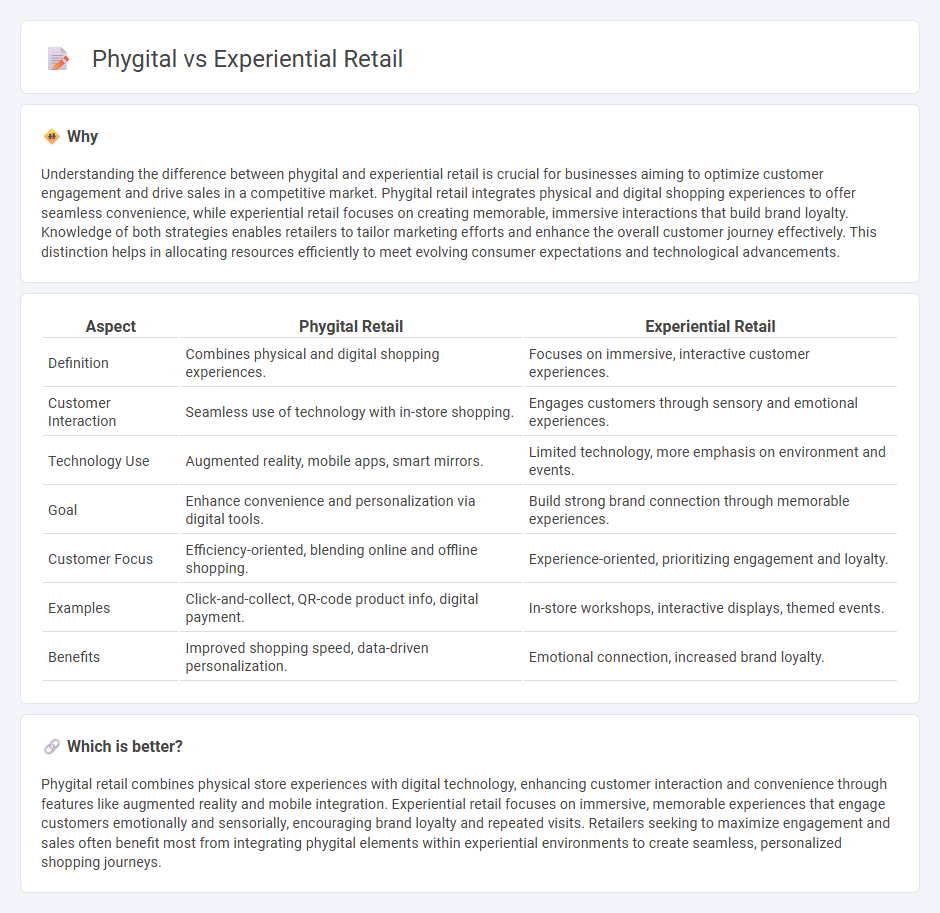
Phygital retail merges physical and digital shopping experiences to create seamless customer interactions, leveraging technologies like AR, QR codes, and mobile apps to enhance convenience and engagement. Experiential retail focuses on immersive environments and sensory experiences that foster emotional connections and brand loyalty by offering personalized, memorable in-store activities. Discover how integrating phygital and experiential strategies can transform the future of retail.
Why it is important
Understanding the difference between phygital and experiential retail is crucial for businesses aiming to optimize customer engagement and drive sales in a competitive market. Phygital retail integrates physical and digital shopping experiences to offer seamless convenience, while experiential retail focuses on creating memorable, immersive interactions that build brand loyalty. Knowledge of both strategies enables retailers to tailor marketing efforts and enhance the overall customer journey effectively. This distinction helps in allocating resources efficiently to meet evolving consumer expectations and technological advancements.
Comparison Table
| Aspect | Phygital Retail | Experiential Retail |
|---|---|---|
| Definition | Combines physical and digital shopping experiences. | Focuses on immersive, interactive customer experiences. |
| Customer Interaction | Seamless use of technology with in-store shopping. | Engages customers through sensory and emotional experiences. |
| Technology Use | Augmented reality, mobile apps, smart mirrors. | Limited technology, more emphasis on environment and events. |
| Goal | Enhance convenience and personalization via digital tools. | Build strong brand connection through memorable experiences. |
| Customer Focus | Efficiency-oriented, blending online and offline shopping. | Experience-oriented, prioritizing engagement and loyalty. |
| Examples | Click-and-collect, QR-code product info, digital payment. | In-store workshops, interactive displays, themed events. |
| Benefits | Improved shopping speed, data-driven personalization. | Emotional connection, increased brand loyalty. |
Which is better?
Phygital retail combines physical store experiences with digital technology, enhancing customer interaction and convenience through features like augmented reality and mobile integration. Experiential retail focuses on immersive, memorable experiences that engage customers emotionally and sensorially, encouraging brand loyalty and repeated visits. Retailers seeking to maximize engagement and sales often benefit most from integrating phygital elements within experiential environments to create seamless, personalized shopping journeys.
Connection
Phygital and experiential retail converge by blending physical store elements with digital technology to create immersive customer experiences that drive engagement and loyalty. Retailers use augmented reality, interactive displays, and personalized digital services to merge sensory in-store interactions with seamless online convenience. This integration enhances customer satisfaction by offering tailored experiences that bridge the gap between virtual and physical shopping environments.
Key Terms
Immersive Experience
Experiential retail emphasizes creating engaging, sensory-rich environments that immerse customers physically and emotionally in the brand, enhancing product discovery and emotional connection. Phygital blends physical and digital interactions, leveraging technologies like AR, VR, and smart mirrors to provide seamless, interactive experiences that bridge online convenience with in-store engagement. Explore how these innovative approaches redefine customer experience and drive retail transformation.
Omnichannel Integration
Experiential retail emphasizes immersive, sensory-rich in-store environments to engage customers directly, while phygital seamlessly merges physical and digital touchpoints through technologies like AR, IoT, and mobile apps for a unified shopping journey. Both strategies prioritize omnichannel integration by connecting online platforms, physical stores, and mobile channels to create consistent, personalized experiences across all customer interaction points. Discover how leveraging experiential retail and phygital innovations can transform your omnichannel strategy for enhanced customer loyalty and sales.
Customer Engagement
Experiential retail immerses customers in multisensory brand environments to foster emotional connections and enhance loyalty, while phygital blends physical and digital touchpoints to provide seamless, interactive shopping experiences. Both strategies prioritize heightened customer engagement through personalized interactions, real-time feedback, and integrated technologies such as augmented reality, mobile apps, and in-store digital displays. Discover how leveraging these approaches can transform your customer engagement and drive business growth.
Source and External Links
Experiential retail - Wikipedia - Experiential retail is a retail marketing approach where customers in physical stores are offered experiences beyond traditional shopping, including interactive art, live music, VR, and cafes, targeting Millennials who value experiences over products.
What is Experiential Retail? An Inside Look - Lightspeed - Experiential retail focuses on engagement rather than sales by creating immersive, on-brand experiences like Glossier's flagship store, where customers enjoy interactive brand-driven environments and non-traditional checkout processes.
6 Best Experiential Retail Examples for 2024 - Bridgewater Studio - Experiential retail creates multisensory, immersive in-store experiences using interactive demos, digital tech (AR/VR), community-building, and shareable moments to foster brand loyalty and transform shopping beyond transactions.
 dowidth.com
dowidth.com